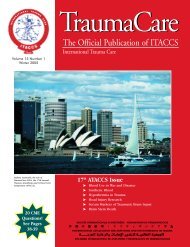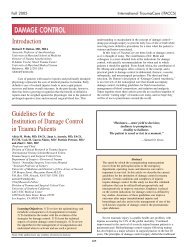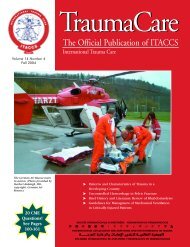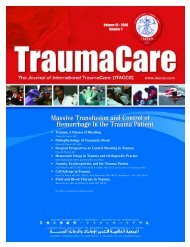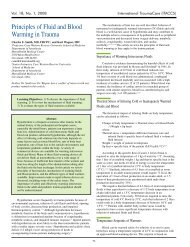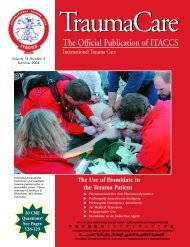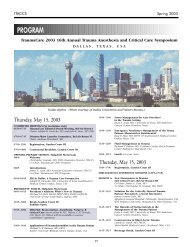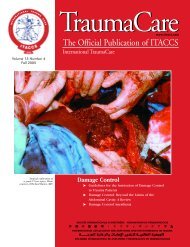The Official Publication of ITACCS - International Trauma ...
The Official Publication of ITACCS - International Trauma ...
The Official Publication of ITACCS - International Trauma ...
Create successful ePaper yourself
Turn your PDF publications into a flip-book with our unique Google optimized e-Paper software.
<strong>ITACCS</strong> Spring 2003<br />
ABSTRACTS<br />
Thursday, May 15, 2003<br />
— Opening Plenary Session —<br />
JFK in Dallas, a <strong>Trauma</strong> Care Perspective<br />
Adolph H. Giesecke, MD<br />
Former Jenkins Pr<strong>of</strong>essor <strong>of</strong> Anesthesiology and Chairman<br />
Department <strong>of</strong> Anesthesiology and Pain Management<br />
University <strong>of</strong> Texas Southwestern Medical Center, Dallas, Texas, USA<br />
<strong>The</strong> management <strong>of</strong> patients following injury continues to evolve as our understanding<br />
<strong>of</strong> the physiology <strong>of</strong> injury improves. Technology advances are providing better diagnostic<br />
options, allowing earlier diagnosis and selective intervention. Noninvasive or minimally<br />
invasive techniques are providing new methods <strong>of</strong> intervention, and therapeutic advances<br />
are providing more options for the management <strong>of</strong> difficult cases and complications.<br />
We have a greater understanding <strong>of</strong> the economic consequences <strong>of</strong> trauma care and<br />
this is driving more selective management for specified patients. <strong>Trauma</strong> care dogma is<br />
increasingly challenged in the light <strong>of</strong> sound science, and investigation or review <strong>of</strong> unproven<br />
beliefs that govern treatment decisions should be a priority.<br />
At the time <strong>of</strong> writing, we once again face the potential for major armed conflict and<br />
perhaps never before has the treat <strong>of</strong> nuclear, biological, and chemical weapons been so<br />
great. <strong>The</strong> challenges and concerns these raise affect us all.<br />
We all have potential roles at local, national, and international levels to improve the<br />
management and outcome for the victims <strong>of</strong> trauma. <strong>The</strong>se improvements will be driven by<br />
the enthusiasm and commitment <strong>of</strong> those involved in trauma care.<br />
Applications <strong>of</strong> Dexmedetomidine in the <strong>Trauma</strong> Patient<br />
Michael A.E. Ramsay, MD, FRCA<br />
Baylor University Medical Center<br />
Dallas, Texas, USA<br />
Learning Objectives:<br />
• To understand the pharmacology <strong>of</strong> α2-adrenoceptor agonists.<br />
• To learn how the properties <strong>of</strong> sedation and analgesia without respiratory<br />
depression may be applied to the management <strong>of</strong> the trauma patient.<br />
• To predict the effect on the hemodynamic pr<strong>of</strong>ile <strong>of</strong> the patient.<br />
I was at Parkland Hospital on November 22, 1963, and assisted in the unsuccessful<br />
attempt to resuscitate the president and gave anesthesia to Governor Connally. I shall<br />
describe the events <strong>of</strong> that day, emphasizing the roles <strong>of</strong> doctors at Parkland, the conclusions<br />
<strong>of</strong> the Warren Commission, the controversy surrounding the conspiracy theories, the conclusions<br />
<strong>of</strong> the Select Committee, the movie “JFK,” and the evidence that closed the case in<br />
1992. <strong>The</strong> lecture is dedicated to Pepper Jenkins, Jim Carrico, and Paul Peters, valued colleagues<br />
who were there and who have subsequently died.<br />
JFK came to Texas to try to heal a rift between Lyndon Johnson, his vice president, and<br />
John Connally, the Governor <strong>of</strong> Texas. While riding past the School Book Depository in his<br />
open-topped limousine, he was shot through the neck and head. Governor Connally, who was<br />
riding in front <strong>of</strong> the president, was shot through the chest, wrist, and thigh. JFK was brought<br />
to Parkland Hospital for an attempted resuscitation, which lasted 25 minutes. <strong>The</strong> doctors who<br />
were primarily involved in the resuscitation were Jim Carrico, Pepper Jenkins, Mac Perry, and<br />
Charles Baxter, assisted by Kemp Clark, Paul Peters, Bob McClelland, and myself.<br />
Lyndon Johnson ordered the body removed to Bethesda, took the oath <strong>of</strong> <strong>of</strong>fice aboard<br />
Air Force One, and ordered Chief Justice <strong>of</strong> the Supreme Court Earl Warren to investigate the<br />
crime. <strong>The</strong> Warren Commission concluded that the shots were fired from one rifle held by one<br />
man, Lee Harvey Oswald, who was perched in the sixth floor window <strong>of</strong> the School Book<br />
Depository. <strong>The</strong> public was not satisfied and conspiracy theories flourished. <strong>The</strong><br />
Congressional Select Committee repeated the investigation in 1979 and concluded that<br />
Oswald was not the only gunman, and the conspiracy included figures from organized crime.<br />
Oliver Stone’s movie, “JFK” staring Kevin Costner released in 1991, was based on the discredited<br />
conspiracy theory proposed by Jim Garrison, the District Attorney <strong>of</strong> New Orleans.<br />
Dennis Breo published the evidence, which convinced me that no conspiracy existed.1<br />
He interviewed the pathologists who did the autopsy; reviewed the films, photographs, drawings,<br />
and microscope slides; and interviewed the key players in the resuscitation_Carrico,<br />
Jenkins, Perry, and Baxter. Based on Breo’s article, GD Lundberg,2 editor <strong>of</strong> JAMA, concluded<br />
that we now have “unequivocal forensic evidence, without reservation that JFK was struck by<br />
two bullets fired from behind, from one high velocity rifle…one gunman.” His conclusion was<br />
confirmed in a carefully researched and written book by GL Posner, called Case Closed.3 All participants<br />
in this congress should visit the Sixth Floor Museum, dedicated to the story <strong>of</strong> the<br />
assassination and housed in the old School Book Depository.<br />
References<br />
1. Breo DL. JFK’s death, the plain truth. JAMA 1992; 267:2794–802.<br />
2. Lundberg GD. Closing the case in JAMA on the John F. Kennedy autopsy. JAMA<br />
1992; 268:1736–8.<br />
3. Posner GL. Case Closed. Random House, New York, 1993.<br />
— Presidents’ Forum —<br />
President’s Address: What’s New in <strong>Trauma</strong><br />
Michael J.A. Parr, MB BS MRCP FRCA FANZCA FJFICM<br />
Intensive Care Specialist, University <strong>of</strong> New South Wales, Liverpool Hospital,<br />
Sydney, Australia<br />
Learning Objective: To summarise some recent advances in trauma management<br />
and to identify topics for future initiatives.<br />
<strong>The</strong> α2-adrenoceptors are located in the central nervous system, peripheral nervous system,<br />
vascular smooth muscle, and a variety <strong>of</strong> other organs. Presynaptic activation <strong>of</strong> the α2-<br />
adrenoceptor modulates the release <strong>of</strong> norepinephrine, resulting in a reduction in the stress<br />
response. In many instances, this reduction can be very beneficial and cardioprotective. In a<br />
shock situation, it could be deleterious when the production <strong>of</strong> catecholamines may be essential<br />
to supporting the circulation. <strong>The</strong> activation <strong>of</strong> the α2-adrenoceptor in the spinal cord and<br />
locus ceruleus in the brain produces analgesia and sedation without respiratory depression.<br />
<strong>The</strong> quality <strong>of</strong> sedation produced is different from most other sedatives that act on GABA receptors.<br />
Dexmedetomidine has a sedative pr<strong>of</strong>ile that resembles non-REM sleep, and patients<br />
roused from sedation can be assessed neurologically without evidence <strong>of</strong> being obtunded. 1<br />
Dexmedetomidine is the most selective α2-adrenoceptor agonist available and is an<br />
imidazole compound, but without the steroid suppression action seen with etomidate. It is<br />
metabolized by the liver into inactive metabolites excreted in the urine. <strong>The</strong> redistribution<br />
half-life is approximately 8 minutes, and it has a terminal half-life <strong>of</strong> 3.5 hours; therefore, it is<br />
a readily controlled sedative when administered as an infusion.<br />
<strong>The</strong> dosing is labeled to allow up to 0.7 mcg/kg/h for 24 hours in initially intubated<br />
patients undergoing mechanical ventilation. Venn et al reported dexmedetomidine use in the<br />
medical ICU for up to 7 days without the development <strong>of</strong> tolerance or dependence and without<br />
any rebound hypertension on discontinuing the drug. <strong>The</strong>y also found that doses as high<br />
as 2.5 mcg/kg/h were required to properly control sedation in this patient group. 2<br />
Dexmedetomidine’s analgesic effect has been shown to reduce the need for opioids<br />
by 50% in postoperative cardiac surgery patients. 3<br />
<strong>The</strong> lack <strong>of</strong> respiratory depression has been demonstrated by Hall et al from measurements<br />
<strong>of</strong> end-tidal CO2, by Ebert et al from arterial blood gas analysis, and from CO2<br />
response curves by Ramsay et al. 4–6 This combination <strong>of</strong> sedation and analgesia with no respiratory<br />
depression lends itself to the management <strong>of</strong> the trauma patient. Controlled sedation<br />
can be maintained while facilitating weaning from mechanical ventilation. Sedation and<br />
pain management can be provided for the head injury patient without risk <strong>of</strong> CO2 retention.<br />
<strong>The</strong> effect <strong>of</strong> dexmedetomidine on cerebral blood flow has been examined in human volunteers.<br />
7 It reduces cerebral blood flow, probably as a result <strong>of</strong> reduced cerebral metabolic rate.<br />
This reduction may be an advantage in the management <strong>of</strong> many head injury patients, particularly<br />
if mechanical ventilation can be avoided.<br />
<strong>The</strong> success in using dexmedetomidine in “fast-track” cardiac surgery patients <strong>of</strong>fers<br />
the potential that chest trauma patients may be managed effectively without the need for<br />
mechanical ventilation or thoracic epidural analgesia.<br />
Dexmedetomidine allows us an opportunity to re-evaluate how we provide sedation<br />
and analgesia to the trauma patient.<br />
References<br />
1. Nelson LE, Lu J, Guo T, et al. <strong>The</strong> alpha2-adrenoceptor agonist dexmedetomidine<br />
converges on an endogenous sleep-promoting pathway to exert its sedative effects.<br />
Anesthesiology 2003; 98:428-36.<br />
2. Venn M, Newman J, Grounds M. A phase II study to evaluate the efficacy <strong>of</strong><br />
dexmedetomidine for sedation in the medical intensive care unit. Intensive Care<br />
Med 2003; 29:201–7.<br />
3. Venn RM, Bradshaw CJ, Spencer R, et al. Preliminary UK experience <strong>of</strong> dexmedetomidine,<br />
a novel agent for postoperative sedation in the intensive care unit.<br />
Anaesthesia 1999; 54:1136–42.<br />
4. Hall JE, Uhrich TD, Barney JA, et al. Sedative, amnestic, and analgesic properties <strong>of</strong><br />
small-dose dexmedetomidine infusions. Anesth Analg 2000; 90:699–705.<br />
5. Ebert TJ, Hall JE, Barney JA, et al. <strong>The</strong> effects <strong>of</strong> increasing plasma concentrations<br />
<strong>of</strong> dexmedetomidine in humans. Anesthesiology 2000; 93:382–94.<br />
6. Ramsay MAE, Jones CC, Knorpp HC, et al. Dexmedetomidine does not depress the<br />
CO2 response curve in postoperative patients. Anesthesiology 2002; 96:A1335.<br />
7. Prielipp RC, Wall MH, Tobin JR, et al. Dexmedetomidine-induced sedation in volunteers<br />
decreases regional and global cerebral blood flow. Anesth Analg 2002;<br />
95:1052–9.<br />
39




